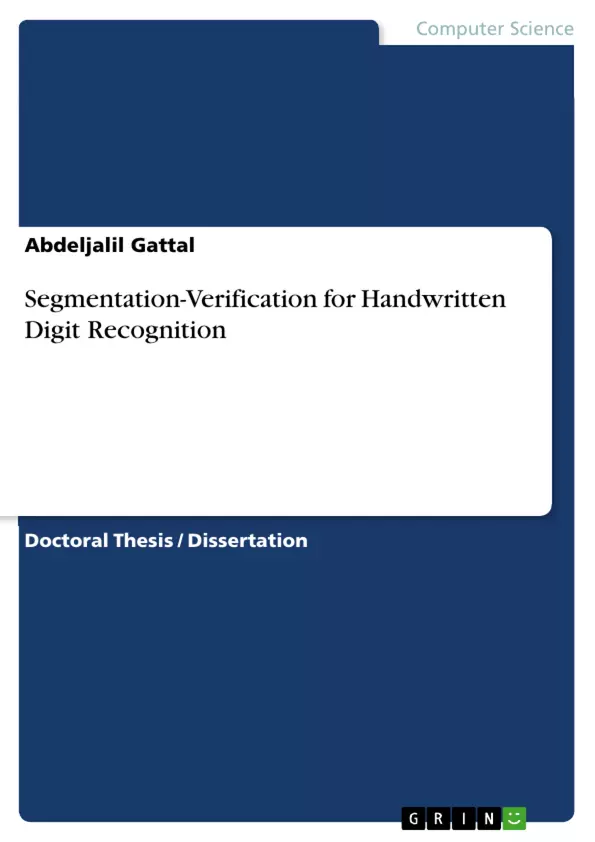Automatic reading of digit fields from an image document has been proposed in several applications such as bank checks, postal code and forms. In this context, two main problems occur when attempting to design a handwritten digit string recognition system. The first problem is the link between adjacent digits, which can be naturally spaced, overlapped or/and connected. The second problem is the unknown length of the digit string, which is not carefully written by people in real-life situations.
In this thesis, SVM-based segmentation-verification system for segmenting two connected handwritten digits using the oriented sliding window is proposed. It employs a segmentation-verification system using conjointly the oriented sliding window and Support Vector Machine (SVM) classifiers. Experimental results showed that the proposed system is more appropriate for segmenting simple and multiple connections. Its main advantage lays in the use few rules for finding the optimal segmentation path. Hence, the proposed approach constitutes a tradeoff between the correct segmentation and the number of the segmentation cuts.
Thereafter, we propose a new design of a handwritten digit string recognition system based on the explicit approach for the unknown-length digit strings. Three methods are combined according the link of adjacent digits, which are the histogram of the vertical projection dedicated for spaced digits, the contour analysis dedicated for overlapped digits and the Radon transform performed on the sliding window dedicated for connected digits. A recognition and verification module based on Support Vector Machine (SVM) classifiers allows analyzing and deciding the rejection or acceptance each segmented digit image. Experimental results conducted on the benchmark dataset show that the proposed system is effective for segmenting handwritten digit strings without prior knowledge of their length comparatively to the state-of-art.
Foire aux questions
What is the focus of this thesis?
This thesis focuses on the development of an Automatic Handwritten Digit String Recognition (AHDSR) system.
What are the main challenges addressed in the thesis?
The main challenges include:
- Segmenting adjacent digits (spaced, overlapped, connected)
- Dealing with the unknown length of digit strings
- Developing a recognition and verification module
What are the key techniques used in the thesis?
The thesis explores several techniques, including:
- Histogram of Vertical Projection (HVP)
- Contour analysis
- Sliding Window Radon Transform (SWRT)
- Support Vector Machines (SVM) for classification and verification
- Oriented sliding window for segmenting connected handwritten digits
What is the proposed system based on?
The proposed system uses a combination of several explicit segmentation methods depending on the configuration link between digits.
What are the main modules of the proposed system?
The main modules are:
- Primary segmentation
- Secondary segmentation
- Digit recognition-verification
What is the purpose of primary segmentation?
Primary segmentation utilizes HVP to initially separate spaced digits in the digit string.
What is the purpose of secondary segmentation?
Secondary segmentation addresses remaining problems after primary segmentation by analyzing potentially overlapping and connected components that were initially rejected. It incorporates contour analysis, SCA, SWRT, and GCA to find potential cuts.
What datasets were used for evaluating the system?
The NIST SD19 handwritten digits database and CVL Single Digit Database are used for evaluating the system.
What are the key findings of the thesis?
The key findings include:
- Combination of features enhances recognition rates.
- Selecting appropriate orientation angle is crucial in SWRT.
- A trade-off should be adopted to balance between accuracy and segmentation complexity
What is the novelty of the research?
The thesis innovates through:
- An explicit approach for segmenting and recognizing handwritten digit strings without prior knowledge of their length
- A segmentation-verification technique based on an oriented sliding window and SVM
- Quote paper
- Abdeljalil Gattal (Author), 2016, Segmentation-Verification for Handwritten Digit Recognition, Munich, GRIN Verlag, https://www.grin.com/document/374168



